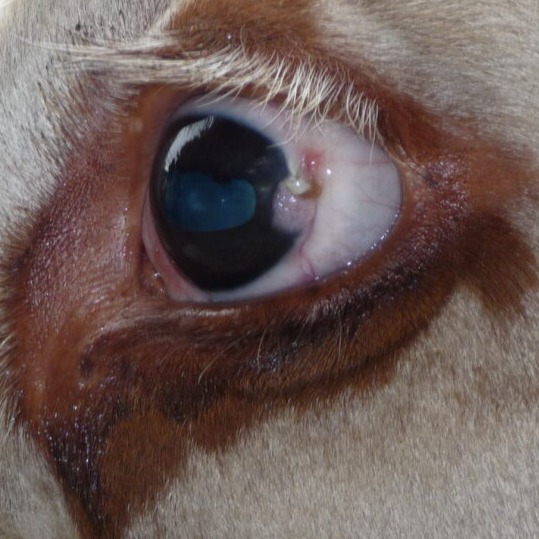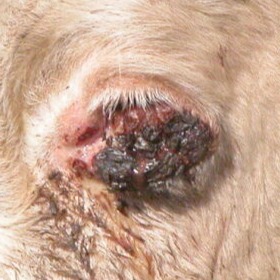Eye cancer in cattle
Eye Cancer In Cattle
WARNING: Some photos on this page could offend some readers. However, this graphical representation is necessary to allow for the correct identification of eye cancers in cattle.
Introduction
Eye cancer, or specifically ocular squamous cell carcinoma, is one of the more common cancers that affect cattle. The cancer commonly involves the third eyelid, eyeball or eyelid areas of cattle.
This disease most commonly occurs in cattle older than 5 years and predisposed breeds include Herefords, Holstein Friesians, Ayrshire, or breeds which particularly have non pigmented eyelids.
Eye cancer is caused by several factors including cattle genetics (including non-pigmented eyelids) and the environment or UV exposure to these non-pigmented areas.
Pathogenesis
This disease begins as a tiny growth, or precursor lesion such as a papilloma or ulcer, of which some develop into cancer. As the disease progresses the eye becomes ulcerated (develops into a painful sore) which can introduce secondary disease such as infection.
Over time the cancerous tissue will also grow inwards, invading the deeper tissues around and behind the eye. It can progress to the lymph nodes of the head and then to body organs such as the lungs and liver.
Clinical signs
Some eye cancers will appear as small, elevated lesions which are white or grey in colour and are found on the third eyelid, eyeball, or eyelid of an animal. Eye cancers can also appear as an irregular raised pink or red mass in these areas. Other signs commonly associated with eye cancer are increased discharge from the eye, haemorrhage from the cancer, necrosis (blackening and sloughing) of the area, fly worry and/or infection.
Treatment
Early detection and action are key in treating this disease. Eye cancers which are less than 2cm in size (figure 1) can be addressed by engaging a private veterinarian to treat when clinical signs are observed or by sending these animals direct to an abattoir for slaughter. Cattle with eye cancers less than 2cm may also be sent to the saleyard for sale to an abattoir for slaughter. As per the normal requirements of cattle presented for sale in a saleyard these animals must not have eyes which are bleeding or have mucopurulent (containing mucus and pus) discharge.


Figure 1– Two individual cases of cows with eye cancers less than 2cm in size, with no bleeding or mucopurulent discharge.
Eye cancer greater than 2cm in size is a Notifiable Disease in Victoria. It is recommended to seek private veterinary assessment to confirm cancer eye and establish if surgical treatment is an option. If an eye cancer is left to develop to an advanced stage of greater than 2-3cm, owners may face animal cruelty charges under the Prevention of Cruelty to Animals Act 1986. Previous prosecution cases for producers found guilty of failing to treat eye cancers can be found at Animal Welfare Victoria record of prosecutions.
If veterinary treatment is not sought Agriculture Victoria advise the following:
a) Cattle owners should note that it is illegal to put cattle with an eye cancer greater than 2cm through a Victorian saleyard and it is also illegal to bring these cattle into Victoria without a permit.
b) Cattle with eye cancers between 2-3cm that are not bleeding, or have discharge may be sent direct to the abattoir at the owner’s risk of non-payment due to carcass condemnation. These cattle must not go in or near a saleyard and ideally are treated or destroyed humanely on farm.
c) Cattle with advanced eye cancer greater than 3cm in size (figure 2) require immediate treatment or euthanasia on farm.

Figure 2– Two individual cases of cows with eye cancers greater than 2cm in size affecting the right eye.
Management
Eye cancer in cattle can lead to animal cruelty charges for stock owners and can have significant economic impact on farm due to carcass condemnation, shortened lifespan in breeding animals and treatment costs. It is advised to regularly inspect all cattle; especially animals that have non-pigmented areas around their eyes.
For more information on eye cancer in cattle please contact your private veterinarian or local Animal Health team at Agriculture Victoria.